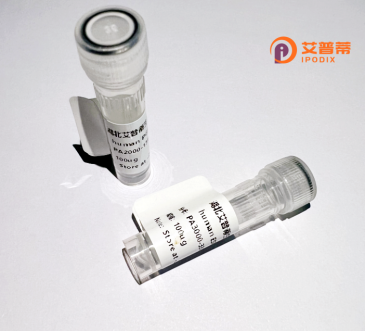
| 纯度 | >90%SDS-PAGE. |
| 种属 | Human |
| 靶点 | FAF1 |
| Uniprot No | Q9UNN5 |
| 内毒素 | < 0.01EU/μg |
| 表达宿主 | E.coli |
| 表达区间 | 1-650aa |
| 氨基酸序列 | MASNMDREMILADFQACTGIENIDEAITLLEQNNWDLVAAINGVIPQENGILQSEYGGETIPGPAFNPASHPASAPTSSSSSAFRPVMPSRQIVERQPRMLDFRVEYRDRNVDVVLEDTCTVGEIKQILENELQIPVSKMLLKGWKTGDVEDSTVLKSLHLPKNNSLYVLTPDLPPPSSSSHAGALQESLNQNFMLIITHREVQREYNLNFSGSSTIQEVKRNVYDLTSIPVRHQLWEGWPTSATDGSMCLAESGLSYPCHRLTVGRRSSPAQTREQSEEQITDVHMVSDSDGDDFEDATEFGVDDGEVFGMASSALRKSPMMPENAENEGDALLQFTAEFSSRYGDCHPVFFIGSLEAAFQEAFYVKARDRKLLAIYLHHDESVLTNVFCSQMLCAESIVSYLSQNFITWAWDLTKDSNRARFLTMCNRHFGSVVAQTIRTQKTDQFPLFLIIMGKRSSNEVLNVIQGNTTVDELMMRLMAAMEIFTAQQQEDIKDEDEREARENVKREQDEAYRLSLEADRAKREAHEREMAEQFRLEQIRKEQEEEREAIRLSLEQALPPEPKEENAEPVSKLRIRTPSGEFLERRFLASNKLQIVFDFVASKGFPWDEYKLLSTFPRRDVTQLDPNKSLLEVKLFPQETLFLEAKE |
| 分子量 | 97.02 kDa |
| 蛋白标签 | GST-tag at N-terminal |
| 缓冲液 | 0 |
| 稳定性 & 储存条件 | Lyophilized protein should be stored at ≤ -20°C, stable for one year after receipt. Reconstituted protein solution can be stored at 2-8°C for 2-7 days. Aliquots of reconstituted samples are stable at ≤ -20°C for 3 months. |
| 复溶 | Always centrifuge tubes before opening.Do not mix by vortex or pipetting. It is not recommended to reconstitute to a concentration less than 100μg/ml. Dissolve the lyophilized protein in distilled water. Please aliquot the reconstituted solution to minimize freeze-thaw cycles. |
以下是与重组人FAF1蛋白相关的3篇代表性文献摘要,格式按要求整理:
---
1. **文献名称**:*"FAF1 suppresses NF-κB activation by recruiting the FAS-associated death domain protein"*
**作者**:Park, YC et al.
**摘要**:研究证明重组人FAF1蛋白通过直接结合FADD(FAS-associated death domain protein),抑制NF-κB信号通路的活化,揭示了FAF1在调控炎症和细胞凋亡中的双重作用机制。
---
2. **文献名称**:*"Expression, purification, and structural characterization of human FAF1 protein in Escherichia coli"*
**作者**:Choi, SJ et al.
**摘要**:该文献报道了一种高效的大肠杆菌表达系统,用于生产可溶性重组人FAF1蛋白,并通过质谱和圆二色光谱验证其结构完整性,为后续功能研究提供了技术基础。
---
3. **文献名称**:*"FAF1 potentiates TNF-α-induced apoptosis by modulating caspase-8 activity"*
**作者**:Kim, JH et al.
**摘要**:研究发现,重组人FAF1蛋白通过增强caspase-8的活性,显著提高TNF-α介导的细胞凋亡效率,表明FAF1在死亡受体信号通路中具有关键调控作用。
---
如需更多文献或特定研究方向(如癌症、神经退行性疾病等),可进一步说明。
Recombinant human FAF1 (Fas-associated factor 1) protein is a engineered version of the endogenous regulatory protein involved in apoptosis, inflammation, and proteostasis. FAF1 contains multiple functional domains, including a ubiquitin-associated (UBX) domain, which facilitates interactions with the proteasome and other partners. It acts as a scaffold or adaptor molecule, modulating pathways such as NF-κB signaling, TGF-β signaling, and the ubiquitin-proteasome system. FAF1 is implicated in cancer (often downregulated in tumors), neurodegenerative disorders, and autoimmune diseases due to its roles in apoptosis induction and stress response regulation.
Recombinant FAF1 is typically expressed in *E. coli* or mammalian systems with tags (e.g., His, GST) for purification and experimental applications. It retains functional domains critical for binding partners like Fas, parkin, or HSP70. enabling studies on its mechanisms in protein degradation, caspase activation, or NF-κB inhibition. Its recombinant form is essential for *in vitro* assays, structural studies, and drug screening for diseases linked to dysregulated apoptosis or proteostasis. Research highlights its tumor-suppressive properties and neuroprotective potential, emphasizing its therapeutic relevance. Optimal solubility and post-translational modifications are ensured during production to mimic native functionality.
×